Which Is The Best Telescope On The UK Market?
Are you looking for a telescope to get started with? When you want to get into stargazing, one of the most important – if not THE most important bit of kit is a telescope. Without a telescope you might just be gazing dreamily at the stars out of your bedroom window!
Perhaps you already have a bit of experience and want to move up in terms of quality and stability so you can look at the objects out there in the vast universe a bit more clearly? Can’t get enough sharpness with your current telescope?
As we all know, there is a vast amount of information out there about a huge range of different scopes. It can be really hard to whittle this down into “What is the best telescope for me?” Well, now you don’t have to whittle, because I have done it for you!
Check out the different telescope reviews I have provided below, so that you can choose the best telescope for you, based on exactly what it is you want to look at.
Best Telescope Reviews [the UK market]
Image |
Product |
Price |
Best for |
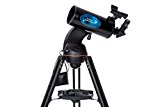 |
Celestron 22202 AstroFi 102 WiFi Maksutov | ££ | Beginners |
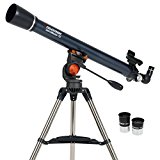 |
Celestron 21061 AstroMaster 70AZ Refractor | £ | Kids |
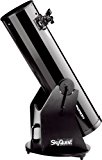 |
Orion 08946e 36x Reflector | ££ | Under £500 |
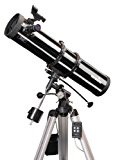 |
Skywatcher Explorer 130M | ££ | Reflector |
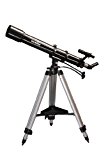 |
Skywatcher Evostar-90 AZ3 | ££ | Refractor |
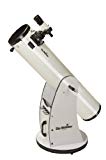 |
Skyliner 200 P Parabolic Skywatcher | ££ | Dobsonian |
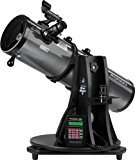 |
Orion 27191 Starblast IntelliScope Reflector | ££ | Computer-ised |
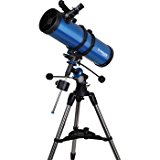 |
Meade Polaris 130EQ MD Reflector | ££ | Planet Viewing |
| Celestron 52304 Regal M2 65ED | ££ | Portable / Travel | |
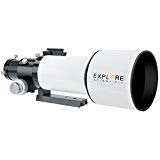 |
Explore Scientific Apochromatic Refractor | £££ | Astro-photography |
1. Best Telescope for Beginners: Celestron 22202 AstroFi 102 WiFi Maksutov
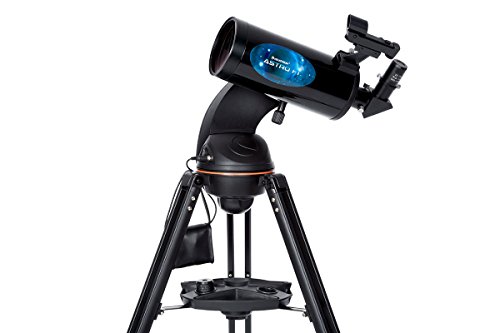
The Celestron 22202 AstroFi 102 WiFi Maksutov wireless rotating telescope is a great one if you are just starting out your stargazing journey. It can be controlled using your smartphone; simply point your phone at the sky and you will receieve information about whatever the telescope is looking at. Not only is this scope easy to set up and use, it’s informative and fun too – what could be better? It generates its own wireless signal, so you don’t even need to be connected to your home Wifi, making it great to take out and about.
What I like about it:
- Gives fantastic images of the Moon, the rings of Saturn, Jupiter’s Red Spot, and more
- It’s super easy to use
- You can create a “sky tour” of all the best celestial bodies, based on your exact time and location
2. Best Telescope for Kids: Celestron 21061 AstroMaster 70AZ Refractor
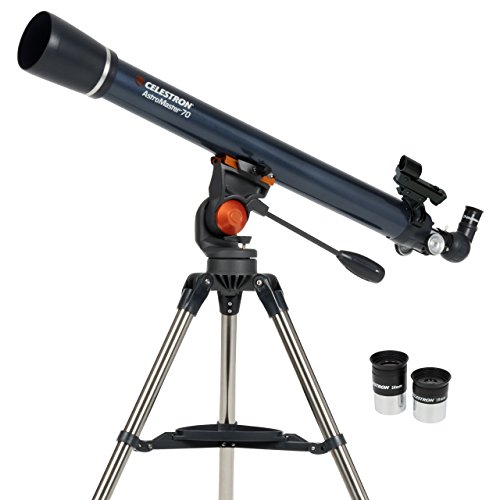
Telescopes for kids have to be good enough that they can get enough good images to keep them absorbed, as well as be easy to use (and relatively cheap, in case the interest wanes quickly)! The Celestron 21061 AstroMaster 70AZ Refractor ticks all these boxes. It can be used for both night sky viewing and daytime terrestrial imagery, meaning that it can keep little people interested before and after bedtime. It’s great for learning about the night sky, as you can download images and print maps with information about them, great for keeping young minds interested in astronomy.
What I like about it:
- Very easy to set up and use
- Gives fantastic clear imagery of the moon, Saturn’s rings and Jupiter’s moons, as well as nebulae and star clusters
- Sturdy stand and ease of use makes it ideal for kids
3. Best Budget Telescope: Orion 08946e 36x Reflector
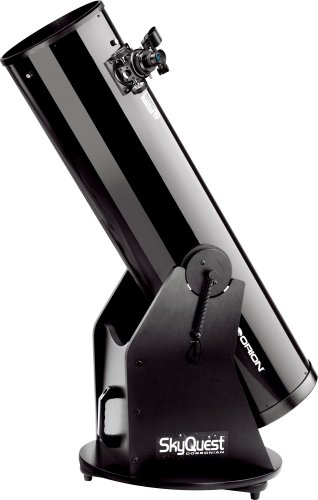
For a fantastic, high performance scope under £500, you should look into the Orion 08946e 36x Reflector. It’s a high quality Dobsonian, with a large aperture and good focal length. It gathers plenty of light, making it great for viewing the deepest of deep space, as well as startlingly clear views of the moon and several planets. It has good magnification, which can be improved still further by adding Barlow lenses. It’s a fairly large scope, with a good weight to it, meaning that you will have to have good storage space for it. If you are looking for a good scope with which you can see glorious detail of some of our close-by neighbours as well as some further afield, then you should look into this one.
What I like about it:
- You get fantastic features for a budget price
- Perfect for deep sky viewing
- It’s easy to operate, with a sturdy Dobsonian base
4. Best Reflector Telescope: Skywatcher Explorer 130M
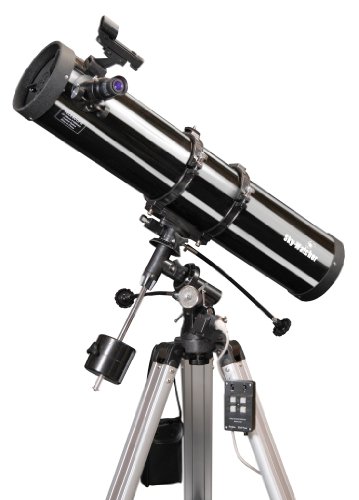
The reflector telescope is not great for terrestrial viewing, but perfect for pointing into the heavens and getting some really good shots of the night sky. If you are looking for the perfect reflector telescope to view some stars, galaxies, planets or nebulae, then the Skywatcher Explorer 130M is for you. This is Newtonian telescope which combines the best of both worlds – able to capture some great imagery of the moon and close-by planets, as well as some really great deep sky pictures. It has an enormous mirror, so that it can gather all available light from any nearby source, making it great for pretty much any conditions. It includes a motor, so that it can track an object moving through the sky without you having to do anything!
What I like about it:
- It’s perfect for deep space as well as some closer planets
- The motorised function, once you get used to it, is a fantastic addition and once which makes the whole journey even more rewarding
- It’s easy to set up, even for beginners
5. Best Refractor Telescope: Skywatcher Evostar-90 AZ3
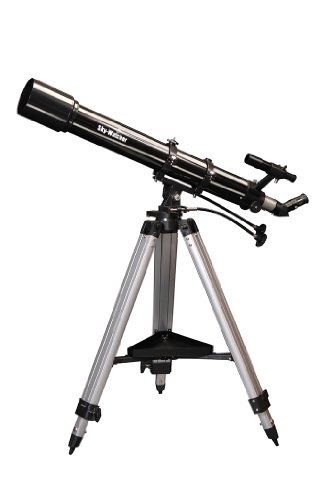
The Skywatcher Evostar-90 AZ3 is a great refractor telescope, suitable for a wide range of abilities and budgets. This scope comes with two different lenses to observe sky objects at different depths. It has a long focal length, and can gather 65% more light than a standard 70mm model, which will give you clear images. It’s ideal for detailed views of the moon, as well as other objects in the solar system. An Alt-Azimuth mount is included, which is high quality and offers stability and strength for good viewing.
What I like about it:
- It’s ideal for professional use, as well as for the user who wants to dip in and out
- Perfect for seeing the moon, Saturn’s rings and Jupiter and its moons
- Affordable but with high spec capabilities
6. Best Dobsonian: Skyliner 200 P Parabolic Skywatcher
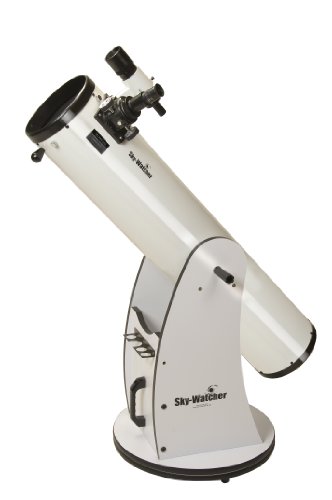
If you have decided that a Dobsonian telescope is the one for you, then you should look no further than the Skyliner 200 P Parabolic Skywatcher. It’s perfect for those who are looking for a more detailed view of the deep dark sky, as it is able to gather as much light as possible from its surroundings. It’s not a computerised telescope, making it ideal for those with a purist bent. The detail shown by this scope is truly breathtaking; you can even see colour differentiation between the A and B rings of Saturn, and a clear view of the Cassini Division.
What I like about it:
- This clever scope is able to see clearly as far as Saturn, and can even show you the Crab Nebula M82 and M81
- Parabolic mirrors help eliminate spherical aberration, making your image even clearer
- It’s not a vastly expensive scope, despite all its amazing specifications
7. Best Computerised Telescope: Orion 27191 Starblast IntelliScope Reflector
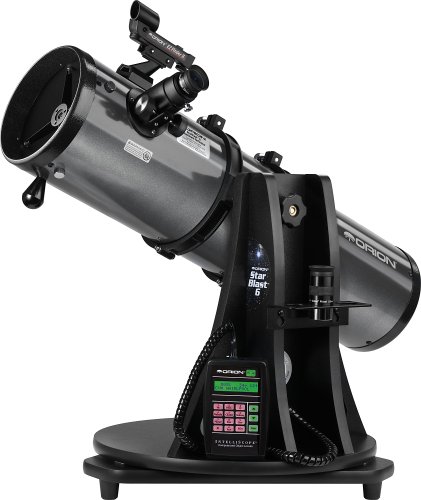
GoTo or computerised telescopes are the new generation of stargazing, and if you are into your gadgetry then you will definitely want to get one! The best one we have found is the Orion 27191 Starblast IntelliScope Reflector. Although it uses manual controls rather than computerised spotting, this does not detract from the overall performance. It is compact and light, making it a great choice to take out and about on stargazing trips, or even just a camping stay where you want to get some great shots of the night sky.
What I like about it:
- It’s so easy to set up that just about any flat surface is ideal – even the bonnet of your car
- Good for poor light conditions
- It’s lightweight, so perfect for taking around with you
8. Best for Planet Viewing: Meade Polaris 130EQ MD Reflector
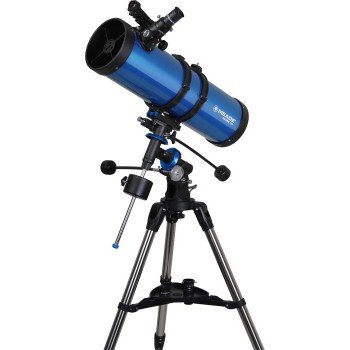
For telescopes that look deep into the night sky and give amazing shots of our celestial neighbours, you would be hard pressed to find a better one than the Meade Polaris 130EQ MD Reflector. With a variety of different eyepieces, you can choose whether you want to view planets, the lunar surface, stars or distant galaxies – all these different things are available right at your fingertips.
What I like about it:
- The red dot finder scope makes it even easier to find and track what you want to look at
- It comes with a prebuilt tripod for easy setting up
- Also included is a DVD with a wealth of knowledge on over 10,000 space objects
9. Best for Travel Portable: Celestron 52304 Regal M2 65ED Spotting Scope
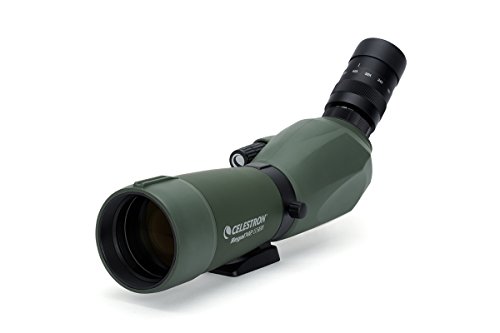
Going out and about and capturing images of the night sky from different places is one of the best things you can do with your telescope. For the best travel portable telescope, look no further than the Celestron 52304 Regal M2 65ED Spotting Scope. This scope is not just for nighttime viewing; you can use it in the daytime for amazing imagery too. Perfect for bird watching or spotting wildlife from afar, the 52304 provides crystal clear images and great focus. The Extra Low Dispersion (ED) glass is ideal for capturing accurate colour reproduction and minimising chromatic aberration. It’s great for those that wish to dabble in astronomy as well as using the scope to view things closer to home.
What I like about it:
- It is lightweight and highly portable
- It is waterproof and nitrogen-purged, which helps to prevent fogging
- Easy to use in any weather conditions as well as low light
10. Best for Astrophotography: Explore Scientific Apochromatic Refractor
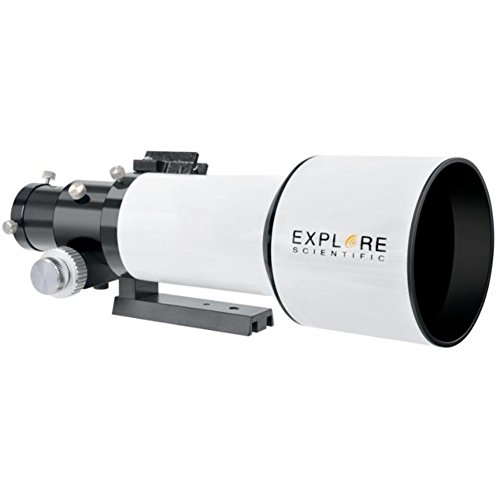
Astrophotography combines looking at beautiful imagery millions of miles away, with creating lasting records of those striking images. If you are looking into astrophotography, you will be looking into the best piece of kit that you can possibly find – and you have found it! The Explore Scientific Apochromatic Refractor AP 80/480 Ed Aluminium OTA is what you have been searching for. The air spaced, triple optical design and diffraction limited optics gives you the sharpest shots you could wish for, and the high quality images produced reflect the quality of the scope.
What I like about it:
- It’s great for beginners as well as the more dedicated enthusiast
- It is compact and portable, meaning that you can take it out and about with you
- Shorter exposure times are made possible with this scope
Few tips before you make your final decision
Before you dig deep into those pockets or remortgage the house to buy all the expensive kit and gadgetry to indulge in this incredibly rewarding hobby, it is a good idea to bear in mind that you really should take a look at the basics first.
A great many would-be astronomers never reach their dreams, because they get frustrated and give up too soon, before they have even learned the basics of the night sky.
If you throw yourself in at the deep end, and expect to seeing deep space nebulae and close up views of Saturn’s rings on your first excursion, you too may end up disappointed!
You really should take some time to get to know what it is you will be gazing into, before you gaze into it using some fairly pricy equipment.
- It’s a good idea to start by getting to know a few basic terms – the horizon, zenith, meridian, the North or South pole, the celestial equator and the ecliptic.
- Find yourself some star charts and maps, and pick out a dozen or so bright stars, and around 10 major constellations. Figuring out where these are and what they look like will give you a good start into astronomy on a larger and more detailed scale.
- Once you have got to grips with these, consider looking into spotting things through a pair of binoculars. You should be able to pick out the moon, Jupiter, Orion, the Pleiades and the Andromeda galaxy. Practising using binoculars is a good step towards spotting these things, and more, through a telescope, and using binoculars can be easier than getting to grips with a scope.
- It’s worth borrowing a friend’s telescope, or popping along to a local astronomy club to try before you buy, as it were. This way you can also get a feel of what you like and don’t like, and start to get an idea about the best telescope for you to invest in.
- Figuring out your surroundings is key – it’s no good getting a telescope that might not be suitable for your particular area, because you will only end up frustrated when you can’t see anything!
- Decide what it is you actually want to see. If you are happiest looking at the moon in detail, or a few of our closest neighbours, then your requirements for the best telescope will be different than if you want to observe deep space.
- Most importantly of all, remember to have fun. After all, what is the point of a hobby if you don’t enjoy it? You can have the best telescope in the world, but it’s usless if you don’t have a good time using it!
Frequently asked questions
1. Why does my telescope view upside down?
All lenses and mirrors display images that are inverted upside down, left to right or rotated. This includes lenses in cameras, our eyes and telescopes. So don’t worry if you are getting an upside down image; your telescope is working fine. If you want to flip the image the right way, use a star diagonal or an erecting prism.
2. What is telescope aperture?
A telescope’s aperture is the size or diameter of the main or objective lens. Aperture is the most important feature to consider when buying a telescope. A larger aperture means a brighter image, better details and the ability to see deeper into the sky.
3. How to make a telescope more powerful? How to increase the magnification of a telescope?
Using an eyepiece with a shorter focal length will increase the magnification of your telescope. This is handy for observing the moon and planets. Attaching a Barlow lens to your eyepiece is another way to make your telescope more powerful (increase magnification).
4. How to aim a telescope?
Point your telescope at the object you want to observe. Look through the finderscope attached to you telescope and adjust the telescope until the object is centered in the scope. Now, look through the telescope’s eyepiece. If you centered the object in the scope, it should also be centered in the eyepiece.
5. How to set up a telescope with an equatorial mount?
Once you place the telescope on the mount, you’ll need to polar align it to be able to track objects. This involves aligning the polar axis of the equatorial mount to the rotational axis of the earth. To do this, you focus the telescope on Polaris if you are in the Northern hemisphere or Octantis if you are in the south.
6. What is a Galilean telescope?
A Galilean telescope is a type of refracting telescope consisting of an objective convex lens and a concave lens that acts as the eyepiece.
The Galilean telescope goes by that name because it is the same design Galileo Galilei used to discover the four big moons of Jupiter and other astronomical objects.
7. How to find Saturn with my telescope?
You first need to find the general direction where it currently is. Use a sky map or star chart to find that location. You can also Google search ‘location of Saturn’ and Google will show you its current coordinates.
Swing your telescope to the right spot in the sky and look for a yellowish-golden bright object that’s shining steadily. Once you find it, use your finderscope to focus on it then increase the magnification of your eyepiece until you can see the planet’s rings.
If you are using a telescope with a GoTo mount, you just need to select Saturn on the hand controller and the telescope will automatically swing to the right location (as long as you’ve aligned it).
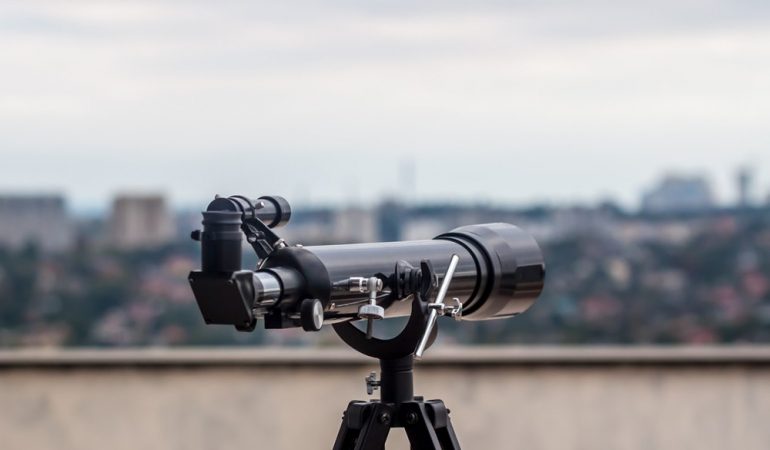
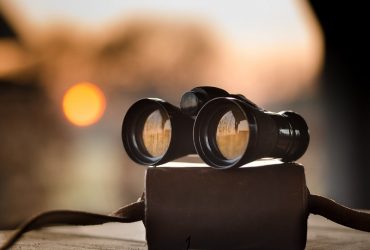
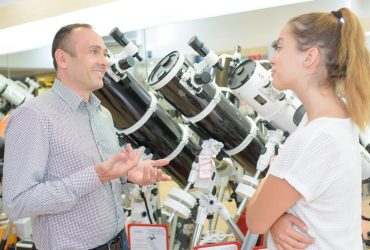
Thank you. Very useful for me as I am a novice and I want to buy my first telescope very soon…and the telescope jargon IS difficult to understand .
But now I am wondering a bit. if it were to be same price…which would be best : TOP-MAX 700x76mm Reflector Telescope or Celestron Travel Scope 70 Telescope ? …as I could get either at a similar price. Maybe the Celestron being £10 or £15 more though.
Thanks a lot,
Melie